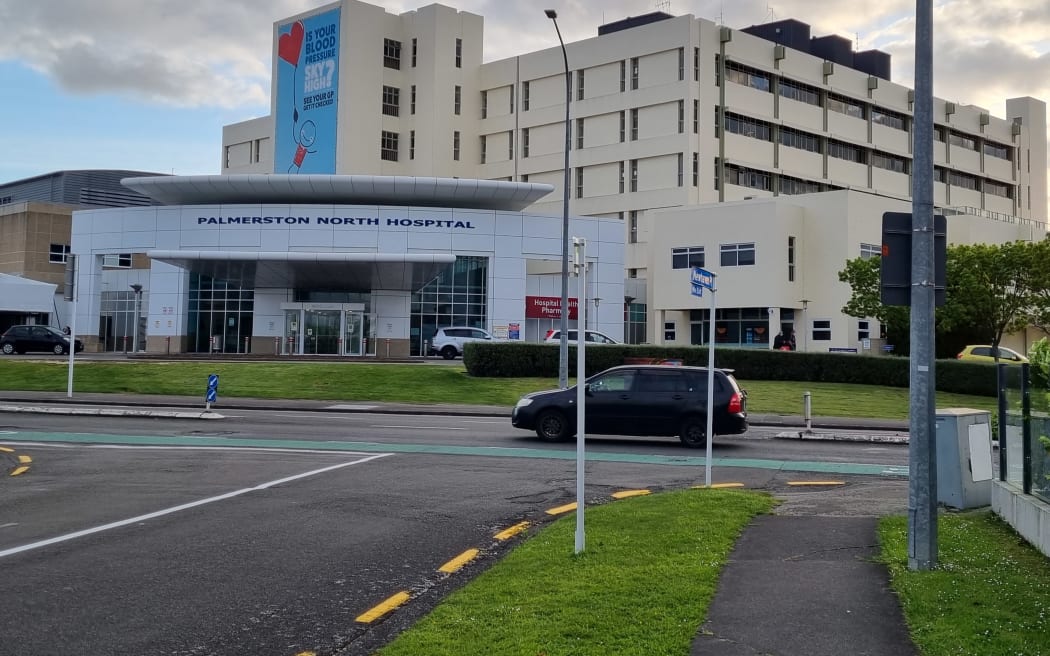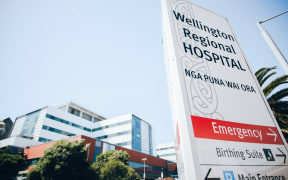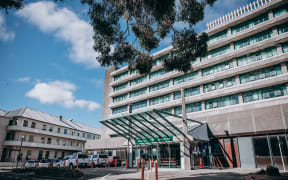New Zealand has almost 100 earthquake-prone hospital buildings, with 35 in high-risk seismic zones.

Palmerston North hospital's water tower and emergency department main entrance are in high-risk seismic zones. Photo: Jimmy Ellingham, RNZ
Health NZ Te Whatu Ora has released a 15-page list showing the New Building Standard ratings of its 1200 building estate - from major clinical blocks to kitchens, from wards to sheds.
They ranged from a rating of just 6 percent NBS for workshops and a boiler in Wellington, to 211 percent at Rātonga-Rua-O-Porirua mental health campus - though a lot of the highest ratings were arrived at by engineers back in 2012, under outdated assessment methods.
Thirty of the 100 quake-prone buildings were of the highest level of importance - level four (IL4). They included operating theatres, emergency departments, some laundries and boiler rooms, which must be up and running after a major shake (hospitals must have hot water for sterilising instruments).
Seventeen of these were at Taranaki and Nelson hospitals, in medium risk zones.
Taranaki's clinical services block and C block rated just 10 percent each; Nelson's ICU and ED were at 30 percent, still below the 34 percent threshold for escaping the earthquake-prone category.
Only five of the 30 IL4 buildings were in high-risk seismic zones, including Palmerston North hospital's water tower at 17 percent and its ED main entrance at 33 percent NBS.
Wellington did not have any IL4 quake-prone buildings, though it did have quite a few Importance Level 2 (IL2) ones.
"Where critical hospital buildings have been declared earthquake-prone in high-risk seismic zones, these buildings are either already being redeveloped or have redevelopment planning underway," Te Whatu Ora said in the OIA response.
It went on to mention Taranaki as "currently under construction" and Nelson as "preparing a business case for redevelopment" - though these are in medium-risk zones.
About 300 hospital buildings are rated between 34-67 percent NBS, which is categorised as 'earthquake-risk' in the legislation.
No other hospital had as pressing a problem as Hutt hospital, according to OIAs from Health NZ and Health Minister Andrew Little.
The OIA list showed Hutt's main Heretaunga block full of wards, radiology and maternity services, at its old rating of 43 percent, instead of its new rating of just 15 percent NBS.
RNZ asked Health Minister Andrew Little how many important hospital buildings nationwide were at risk of similar disruption as at the Heretaunga block - where health leaders were trying to decide how soon to demolish and rebuild.
HNZ's infrastructure and investment group "has not been advised of any imminent seismic remedial actions required similar to those announced" in the Hutt, Little said.
The progress on "remedial actions" elsewhere was not rapid in the lead up to the health reforms. The number of Importance Level 3 or 4 hospital buildings that were quake-prone was about the same as it was in 2020, when it numbered 52.
Little said that under the reforms, Te Whatu Ora was developing a seismic programme of work with a risk management strategy and policy to help identify additional measures the sector could take to minimise disruption.
That work, including where to put patients and services when buildings needed emptying or fixing, was due to be finished at the end of this year.
The way health authorities report on seismic resilience was in line with expert guidance, the minister said.
Health authorities were keen to stress that NBS ratings were not a safety assessment, or indicative of a building at risk of imminent failure in a quake but rather a signal to address a building's weakest parts.





